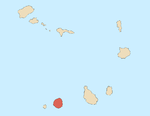Curral Grande
This article needs additional citations for verification. (March 2014) |
Curral Grande | |
|---|---|
Settlement | |
| Country | Cape Verde |
| Island | Fogo |
| Municipality | São Filipe |
| Civil parish | São Lourenço |
| Population (2010)[1] | |
| • Total | 398 |
| ID | 82104 |
Curral Grande is a settlement in the western part of the island of Fogo, Cape Verde. It is situated 8 km northeast of the island capital São Filipe.
History
In the past, the village of Curral Grande was important not only for its agricultural potential as well as a dynamic social festivities marked by religious, cultural and sports activities which attracted a large number of people from almost all the island of Fogo. The celebration of New Year - on January 1 to mark the entry of the new year - was a major celebration of the local population, where the program included various activities such as: Horse Racing on the Neté road, cockfight, football tournament, theatrical presentation and the traditional dance of violin (badju rabeca). The football team "The Apollos" earned some prestige at the local level and was later to adopt the name União de São Lourenço ("Union of St. Lawrence") thus gaining a greater projection across the parish of St. Lawrence.
Among the religious festivities the Flags of St. John and St. Peter assumed greater prominence with the conduct of processions starting from the chapel of St. Peter and travelled by the main road to Curral Grande. The enthusiasm of the coladeiras (music genre from Cape Verde) and beating of drums gave a special touch to those festivities.
Being a countryside village of the island of Fogo, the rain-fed agriculture and cattle breeding are the main economic activities of subsistence of the population. In the past the village had some workshops, particularly from carpentry and shoe shop.
In colonial times, and in the scope of the project then called "Brigada Hidráulica", a large reservoir was built to retain and store rainwater. Just because of existence of that reservoir, even though the water was not of good quality, made many people from other places to flow to Curral Grande in search of water, the precious liquid.
However, over the years, two factors caused a sharp decrease in the population of Curral Grande. First, mass emigration of its people, especially to the United States of America and Portugal, which intensified starting from the independence of Cape Verde in 1975. Second, the internal migration towards urban centers motivated by successive years of drought. With the group of young people largely absent, the football field was taken to build a Health Center and the festivities above, disappeared. Those active social life of the past died almost entirely.
Indeed, in 2009, can be noticed, a reverse flow of people. The return of emigrants already retired who prefer to go back to their homeland, and thus, Curral Grande has registered constructions of new homes at a good pace. Already has electricity and telephone network that covers much of its population. The construction of a fountain by the government, helped to minimized the sacrifice of the people who in the past had to travel several kilometers in search of drinking water.
Major public and religious buildings (year 2009):
- Kindergarten built by Capuchins
- Primary schools
- Secondary schools
- Health Center
- Chapel of St. Peter
- The Seventh Day Adventist Church
See also
References
- ^ "2010 Census results". Instituto Nacional de Estatística Cabo Verde (in Portuguese). 24 November 2016.

